This is the final Kayaking with Killers post in a series of three about kayaking with the resident orcas in Johnstone Strait off the coast of British Columbia. You can read the previous two posts Kayaking with Killers (1) and Kayaking with Killers (2) by clicking on the links.
The activities on our first full day at Shaker Camp was determined by the weather and sea conditions. Setting out to circumnavigate the large island on which we were camping we had to turn back once we left the lee of the island. Sea and wind conditions made paddling extremely difficult so we contented ourselves with observing a colony of harbour seals basking on the seaweed covered rocks before returning to camp.
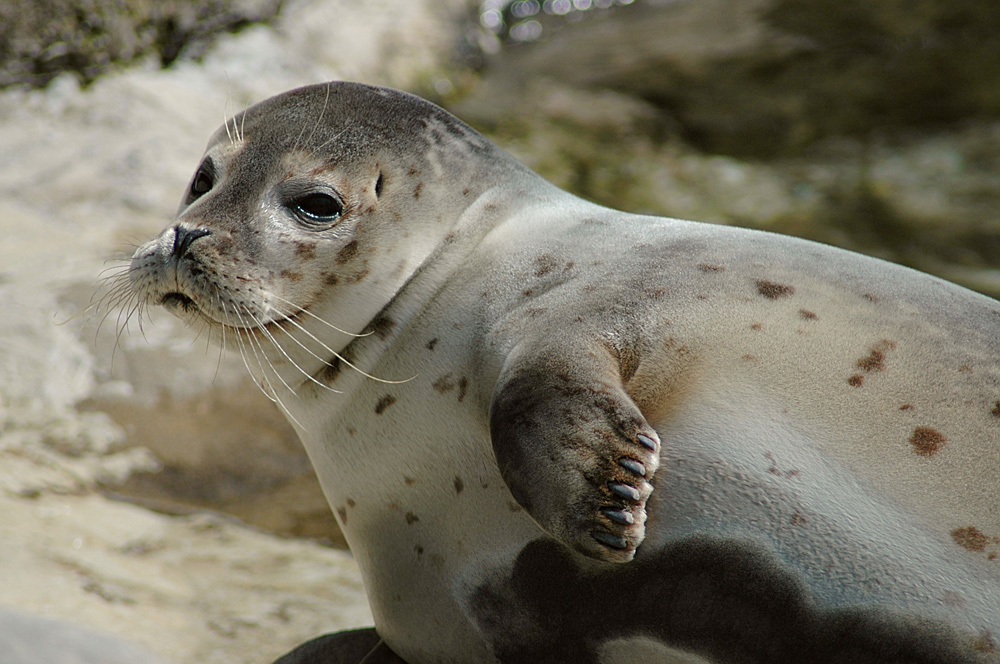
© Marcel Buckhard – source: www.wikimedia.org – used under the creative commons licence
As paddling was off the menu several of us hiked up Lookout Hill for a grand overview of the archipelago. From such a vantage point it was easy to see how many islands there were and how easy it was to make navigational errors so close to the water in a kayak.
The following day we planned to cross Johnstone Strait, almost 2km wide, and explore along the opposite shore. We could put in a lot of effort crossing the strait only to find the orcas swimming down the shore we had just left. That is the nature of whale-watching from a kayak; you cannot follow them you have to hope they come to you or that your paths cross. Orcas or not it would be a great days kayaking in splendid scenery.
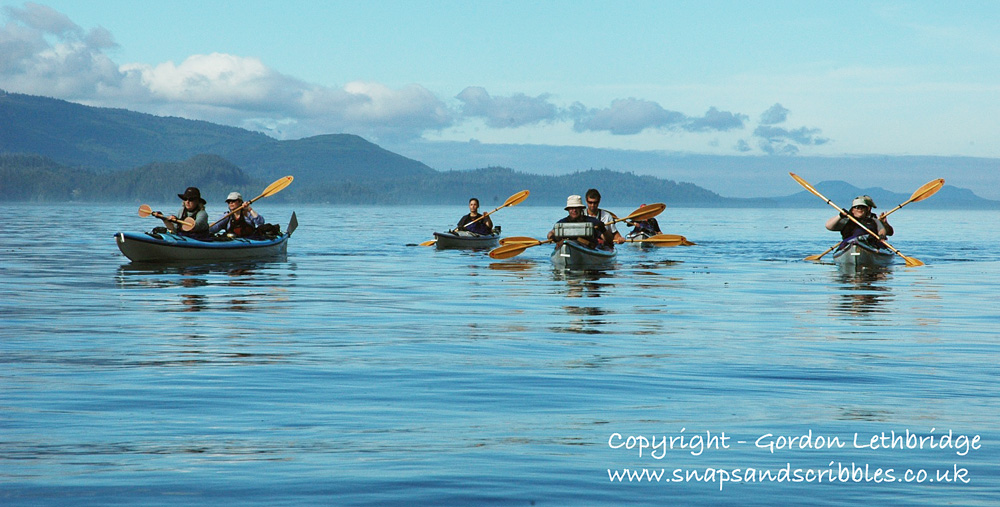
The weather was set fair and the sea was mirror calm. Vancouver Island’s eastern side is where the mountains come right down to the sea. Where they meet are a few pebble beaches. One in particular near Robson Bight, is a favourite with the orcas for pebble running. This unique behaviour has only ever been recorded here and has featured on a number of nature films. It has been declared a reserve and no boats or people are allowed in the reserve or on land anywhere near it so as not to disturb the orcas. It is thought that this behaviour, unique to the local pods removes parasites and dead skin.
The orcas often come here not only to rub but also to feed. Where Blackwater Sound and Johnstone Strait converge there are plenty of salmon. Our chances of seeing orcas were pretty good.
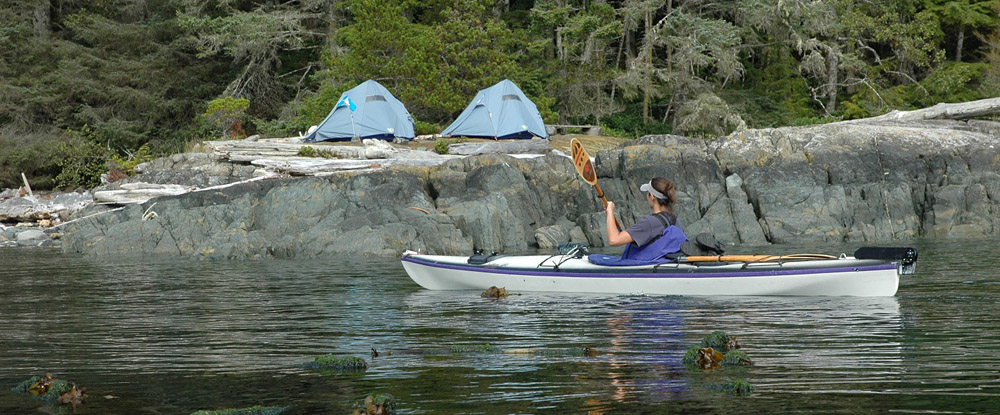
Paddling across the strait was like crossing a large river as the tide was running at about 3 knots. We pointed the canoes at a point up-tide from where we wanted to be and allowed the tide to carry us towards the beach where we planned on taking lunch.
Almost every trip we made was dependent on tidal and weather conditions so start time could vary by a couple of hours. We had a mid morning departure so that we would arrive on the far side just before noon. Once we arrived off the beach a couple of kayaks put in for the occupants to answer the call of nature while the rest waited 50 metres offshore. As it turned out this was a fortuitous turn of events.
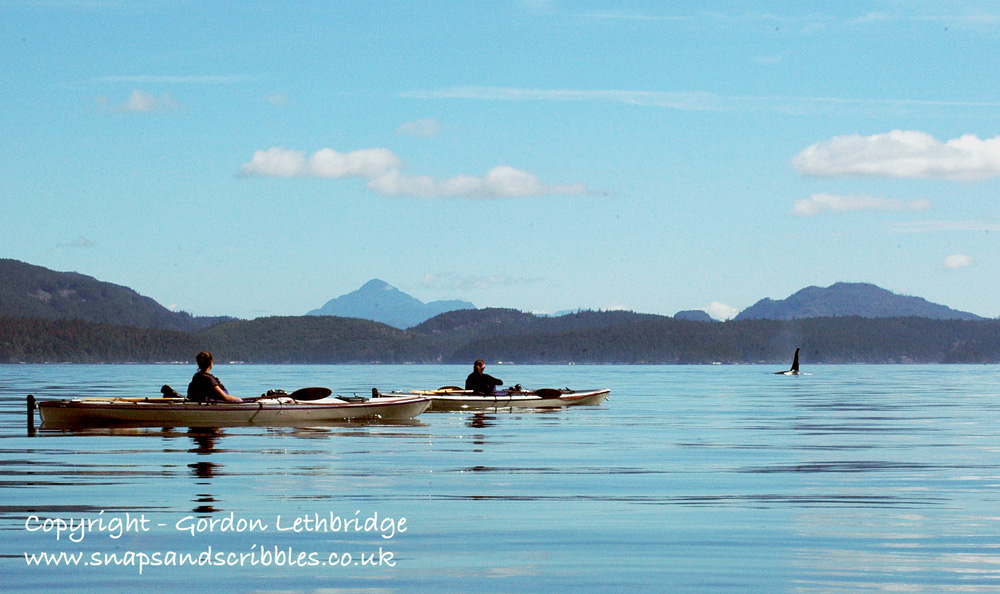
By the time the call of nature had been answered and the kayaks were afloat again the group was spread over a fairly large area instead of our usual rafting up for resting. Radio chatter indicated that there were a couple of pods of orca off Robson Bight about 1 kilometre to the south. One of these was reported as heading up the shore to where we were. No time to raft up as we spotted an orca blowing. The thin veil of mist as it exhales is barely visible but once seen is unmistakable. There were several other blows in quick succession. The orca were headed in our direction.

We drifted gently until we were certain that they were heading in our direction and just kept quiet hardly dipping our paddles in the water. The orca has a well-developed echolocation system and would know exactly where we were. It was up to them to chose to divert around or ignore the brightly colour fleet of kayaks and their occupants.
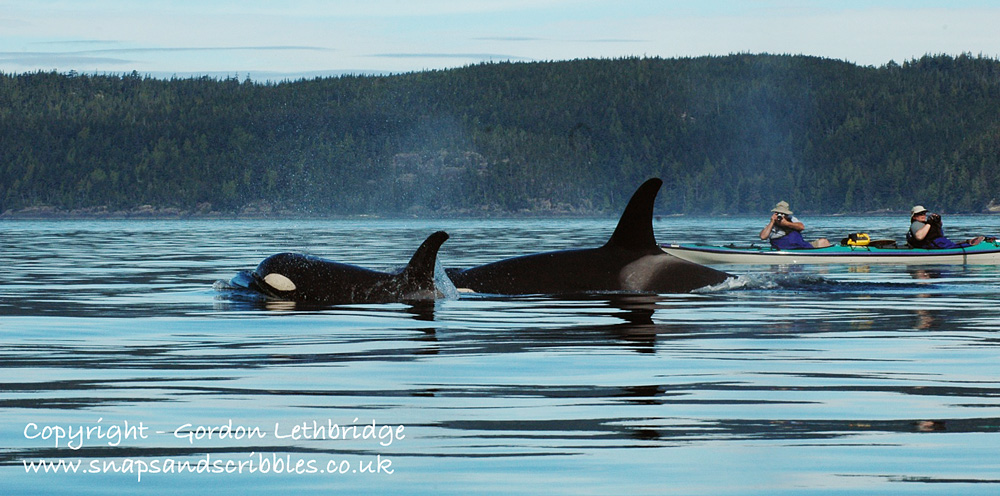
The orcas chose to ignore the brightly coloured kayaks. They were not even inquisitive; indicating perhaps that they accepted kayakers as part of the scenery. The pod did not swim by with the single-minded purpose of the orcas we had seen the previous day. These were close in shore and were fishing and diving possibly to rub along the pebbles of the beach.
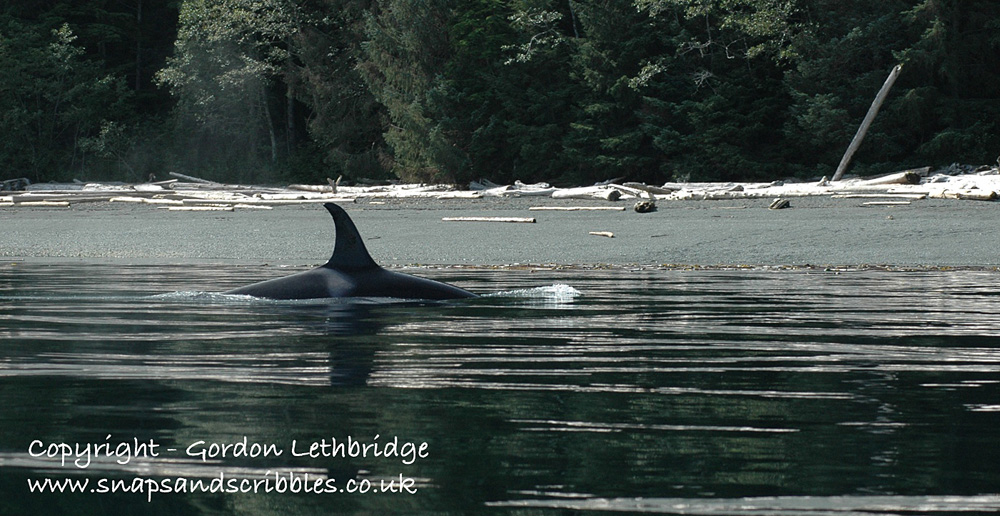
As we were spread out a little, not having rafted up, and the orcas came between and around us. They came closer than they would have done to a larger raft of kayaks as they paid less attention to individual kayaks. As they swam between us we were able to get up close and personal with them. Being only 10 feet from the world’s most efficient predator with only a few millimetres of hull between you and the water is an awesome experience.
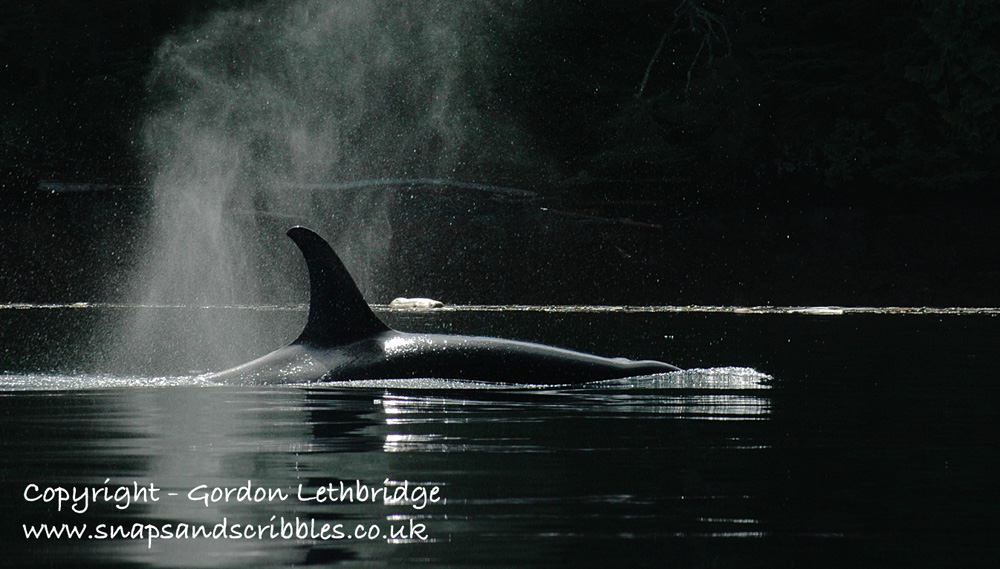
The orca’s echolocation system ensured they knew exactly where we were so it was them who made the decision to approach and ignore our group. In the vast expanse of Johnstone Strait they could have taken a detour round us in clear water.
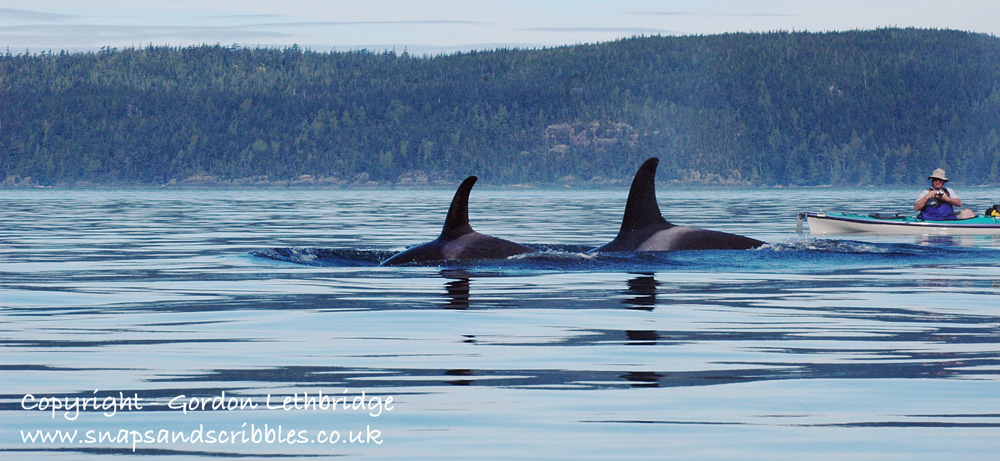
A mother and her youngster surfaced between two kayaks, exhaled a cloud of water vapour and dove again resurfacing moments later behind us. A little way out in the strait the two metre fin of the alpha male was visible like the glistening black conning tower of a submarine. He was patrolling his pod. Males are easily identified by their much larger dorsal fin which can reach two metres in height. However, despite his size he is not the boss. The alpha female is the boss. She decides where to go and when; he just follows.
Each pod consists of families and sub-families of mostly females and young males. There is only one mature male in each pod. DNA analysis has shown that the alpha male, although he is of the same genetic line, is not the father of the offspring of the pod. However, the same DNA analysis has shown that the alpha male has paternity rights with other resident pods in the area. Although he swims with and protects his family pod he does not father the offspring. It is by this means that the genetic pool is kept strong.
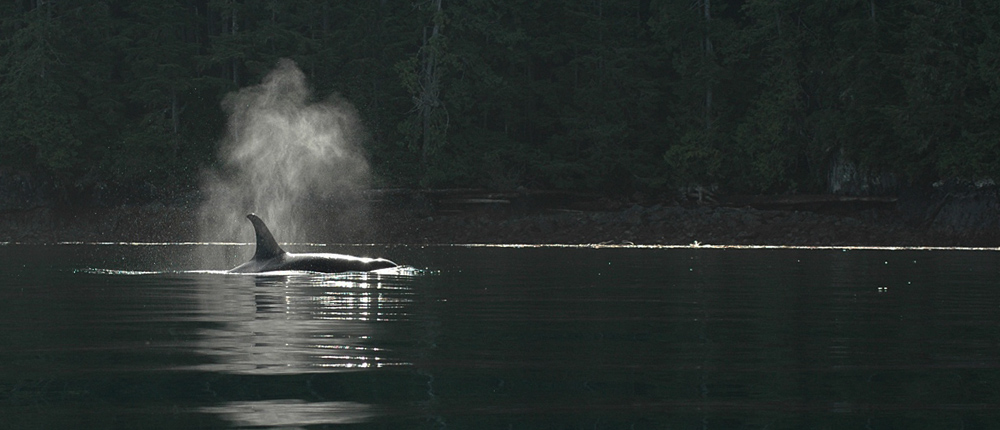
The orcas continued their leisurely swim past us surfacing numerous times, their black fins and backs gleaming in the sunlight. We felt privileged that they had not detoured round us but had swum close by in a relaxed way. It was a fitting finale to our trip as tomorrow we left for Port Macarthy and a short float plane flight back to our waiting international flights home.
For multi-day kayak tours whale-watching try Sea Kayak Adventures


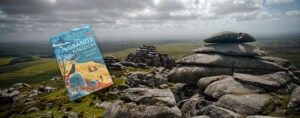
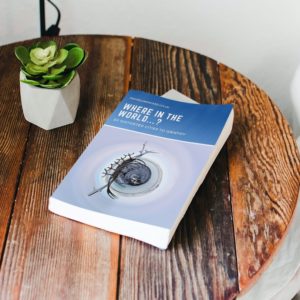
One thought on “Kayaking with Killers (3)”
Wow! This looks like a wonderful adventure! Really like the photo’s!
Comments are closed.